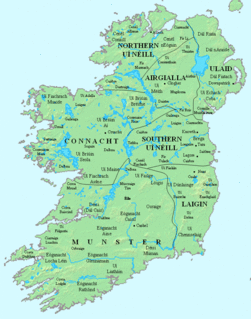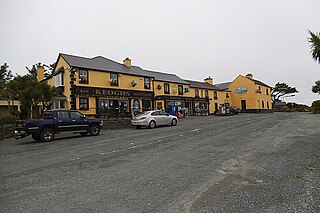Related Research Articles

Connemara (Irish: Conamara[ˌkʊnˠəˈmˠaɾˠə]) is a region on the Atlantic coast of western County Galway, in the west of Ireland. The area has a strong association with traditional Irish culture and contains much of the Connacht Irish-speaking Gaeltacht, which is a key part of the identity of the region and is the largest Gaeltacht in the country. Historically, Connemara was part of the territory of Iar Connacht. Geographically, it has many mountains, peninsulas, coves, islands and small lakes. Connemara National Park is in the northwest. It is mostly rural and its largest settlement is Clifden.
The Conmhaícne Mara or Conmaicne Mara, were an early people of Ireland. Their tuath was located in the extreme west of County Galway, Republic of Ireland, giving their name to Connemara, an anglicised form of Conmhaicne Mara.
Roderick O'Flaherty was an Irish historian.

West Connacht was a kingdom of Gaelic Ireland, associated geographically with present-day County Galway, particularly the area known more commonly today as Connemara. The kingdom represented the core homeland of the Connachta's Uí Briúin Seóla kindred and although they ruled, there were smaller groups of other Gaels in the area, such as the Delbhna Tir Dha Locha and the Conmhaícne Mara. It existed from 1051 onwards, after the Ó Conchobhair, Kings of Connacht, pushed the Ó Flaithbheartaigh to the West of Lough Corrib, from their original territory of Maigh Seóla. Iar Connacht remained a subordinate túath of Connacht, until the 13th century, after which it was more independent.

Maigh Seóla, also known as Hy Briuin Seola, was the territory that included land along the east shore of Lough Corrib in County Galway, Ireland. It was bounded to the east by the Uí Maine vassal kingdom of Soghain and extended roughly from what is now Clarinbridge in the south to Knockmaa Hill in the north. Its rulers belonged to the Uí Briúin Seóla and are sometimes found in the annals under the title "King of Uí Briúin" and "King of South Connacht". The earliest identifiable kings belonged to the line that became the Clann Cosgraigh. However in later times the line which would become the Muintir Murchada, under the O'Flaherty chiefs, monopolized the kingship.

O'Flaherty, is an Irish Gaelic clan based most prominently in what is today County Galway. The clan name originated in the 10th century as a derivative of its founder Flaithbheartach mac Eimhin. They descend in the paternal line from the Connachta's Uí Briúin Seóla. They were originally kings of Maigh Seóla and Muintir Murchada and as members of the Uí Briúin were kinsmen of the Ó Conchubhair and Mac Diarmada amongst others. After their king Cathal mac Tigernán lost out to Áed in Gai Bernaig in the 11th century, the family were pushed further west to Iar Connacht, a territory associated with Connemara today. They continued to rule this land until the 16th century. The name has been alternatively rendered into English in various forms, such as Flaherty, Faherty, Laverty, Flaverty, Lahiff, and Flahive.

Ballyconneely is a village and small ribbon development in west Connemara, County Galway Ireland.

The Uí Briúin were a royal dynasty of Connacht. Their eponymous apical ancestor was Brión, son of Eochaid Mugmedon and Mongfind, and an elder half brother of Niall of the Nine Hostages. They formed part of the Connachta, along with the Uí Fiachrach and Uí Ailello, putative descendants of Eochaid Mugmedon's sons Fiachra and Ailill. The Uí Ailello were later replaced as the third of the Three Connachta, through genealogical sleight of hand, by the Uí Maine.

Castle Hackett is a 13th-century tower house at the base of Knockma hill, 10 kilometres (6 mi) south-west of Tuam, County Galway, Ireland.
The Conmhaícne Mheáin Maigh or Conmaicne Mhein or Conmaicne Máenmaige or Conmaicne Críche Meic Erca, were an early people of Ireland, their tuath comprising the barony of Loughrea, in County Galway.
Urchadh mac Murchadh was King of Maigh Seóla.
Ruaidhri Ó Flaithbheartaigh was King of Iar Connacht and Chief of the Name.
Morogh Ó Flaithbheartaigh was King of Iar Connacht and Chief of the Name.
Clann Cosgraigh or Clann Coscraig was a branch of the Uí Briúin Seóla dynasty and also the name of the district on the eastern side of Lough Corrib, County Galway which they inhabited and ruled prior to the Norman invasion.

Ó Conghalaigh is a Gaelic-Irish surname. It derives from the forename Conghal, meaning "fierce as a wolf". It is often anglicised as Conly, Conley, Conneely, Conneeley, Connolley, Connelley, Connalley, Connally, Connolly, Connelly, Connely or Ó Conghaile.
Coolcarney, also called Callraighe of Cuill, was an Irish district located in Connacht, within the Barony of Gallen stretching across both County Mayo, and County Sligo. It was unique in that it was a separate principality of the Uí Fiachrach from the rest of the Barony of Gallen.
The Conmhaícne Luacháin or Cenel Luchain, were an early people of Ireland, whose tuath comprised the parishes of Oughteragh and Drumreilly, barony of Carrigallen, in southern County Leitrim.
The Cluain Conmhaícne, or Cluain Conmaicne, were an early people of Ireland. Their tuath comprised the entire parish of Cloone, located in the baronies of Maigh Rein (Mohill) and Carrigallen, in south County Leitrim.
The Conmhaícne Angaile were an early people of Ireland. Their tuath comprised the territory of Annaly, now County Longford.
The Conmhaícne Cúile or Conmaicne Cuile Tolad were an early people of Ireland. Their tuath comprised, at minimum, most of the barony of Kilmaine, in County Mayo.
References
- ↑ "The History of Connemara". Archived from the original on 5 November 1999. Retrieved 2 April 2010.
- ↑ http://mike.rtc-galway.ie/ireland/connemar.html%5B%5D
- ↑ A chorographical description of West or H-Iar Connaught / written A.D. 1684, by Roderic O'Flaherty
- ↑ O'Flaherty, Roderic (1846). A Chorographical Description of West or H-Iar Connaught: Written A.D. 1684. For the Irish Archaeological Society.
A chorographical description of West or H-Iar Connaught / written A.D. 1684, by Roderic O'Flaherty.
- ↑ Lord Killanin, Notes On Some Of The Antiquities Of The Barony Of Ballynahinch, CO. Galway. Journal of the Galway Archaeological and Historical Society Vol. 25, No. 3/4, 1953/1954
- ↑ The O'Flaherty Country E. W. Lynam Studies: An Irish Quarterly Review Vol. 3, No. 10 (Jun. 1914), pp. 13–40 Published by: Irish Province of the Society of Jesus
- ↑ A chorographical description of West or H-Iar Connaught / written A.D. 1684, by Roderic O'Flaherty , Page 237